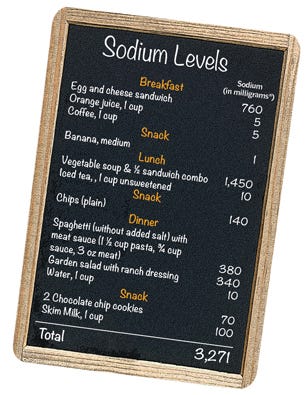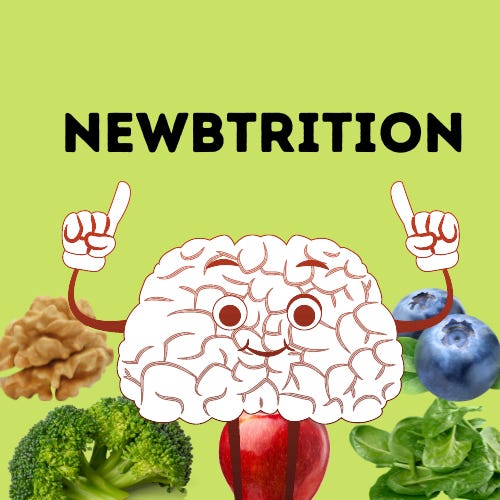Be spicy where you once were salty
The way sodium slinks into so many foods (especially in America) is sneaky, and borders on sinister
IMPORTANT: I’m not a doctor or a nutritionist. Take all of this with a grain of salt … while watching your salt intake.
As this “Newbtrition” journey unravels, I’ll argue that certain habit improvements (such as eating more fruits and vegetables) are easier than they might seem.
But here’s one thing that really seems like a challenge, especially if you’re sticking with processed foods most of the time: cutting down on sodium.
And, I hate to get preachy, but … you almost certainly need to halt the salt.
Maybe this math part is boring but if it scares even a few of us, it may save/extend/improve lives
Via the CDC, the Average American consumes 3,400 milligrams (mg) of sodium each day, compared to the recommended maximum of 2,300 mg of sodium. Most Americans loading up with more than 1,000 extra mg per day than recommended is already bad, and it gets scary when you consider that the American Heart Association’s recommendation is even lower (1,500 mg).
Studies indicate that somewhere between 70-75% of that sodium comes from processed foods and/or foods from restaurants.
TUFF people might point out that certain foods fall under the “you should know better” category. But, again, don’t beat yourself up. Because things really add up with the stuff you wouldn’t always expect. Those chuds would normally use the phrase “slippery slope,” although they’d just be trying to limit someone’s human rights or what-have-you.
Anyway, this graphic from the CDC does a good job capturing how you can suddenly consume far more sodium than you may realize throughout a given day:
If you’re (did someone yell “ZEALOUS?!?” … oh no, was that person my sweet wife?) like me, you might try to massively cut down on processed foods altogether. I’d guess that I hover in at 1,500 mg per day even with the best intentions. (You really don’t need a whole lot of sodium per day, with some estimating 200-500 mg.)
Let me take a wild guess, and assume you’re not on some weirdo Quest to optimize your health. Maybe you just want to get closer to that healthy-ish range?
My favorite tweaks revolve around spices. But if you just want to keep things simple, “How Not to Die” author Dr. Michael Greger passed along some helpful tips.
If we do buy processed foods, there are two tricks we can use. First, try to only buy foods with fewer milligrams of sodium on the label than there are grams in the serving size. So, if it’s a 100 gram serving size, it should have less than 100mg of sodium. Or, second, you can shoot for fewer milligrams of sodium than there are calories. For example, here the sodium is 720; calories are 260. 720 is greater than 260; so, this has too much sodium.
That’s a trick I learned from one of my favorite dieticians of all time, Jeff Novick. The reason it works is because most people get about 2,200 calories a day; so, if everything you ate had more calories than sodium, you’d at least get under 2,300 milligrams of sodium – the upper limit for healthy people under age 50. Of course, the healthiest foods have no labels at all …
(I thought I’d leave an extra line about foods with no labels at all in there, sorry.)
From a practicality standpoint, I’d assume that the “less sodium than calories” rule might be the easiest idea to implement right off the bat. But I could be wrong.
Spices feel like a cheat code for sodium replacement
Maybe some of this stuff is super-obvious. However, I’d wager most people have no idea about something crucial enough (to me) that I’ll write it all big and loud and bold.
Replacing salt with spices (without salt-added) doesn’t just replace almost all of the sodium in a meal prep. They also often carry health benefits strong enough to be genuinely stunning. Oh yeah, they also usually make things taste really good.
Who would have thought that oregano isn’t just a spice that makes pizza taste even better, but it’s actually good for you?
As with everything you read about in “Newbtrition,” I’d recommend outside research. In the case of spices, that would mean a) finding out which ones bring the benefits you want the most and b) learning which ones you’ll use/force into smoothies and other food most often.
Here are some spices and/or powders that I try to consume every day, even if it means plopping them into foods where they don’t belong, shakes, or tea (many teas are extremely good for you, by the way, but that’s a post for another day):
Turmeric (which I’ve mispronounced as two-meric* for a couple weeks, minimum) is one of the spices that gets singled out as almost outrageously healthy. Studies indicate that turmeric can help prevent cancer and heart disease, along with … you know what, just read up. I find it stunning that a little bit of turmeric can do so much. It’s commonly found in curry powder (which has black pepper, something that may make turmeric even more potent, and other spices that are beneficial, such as fenugreek). If you can’t naturally add turmeric to appropriate foods — you really don’t need to use much, it’s apparently quite potent — then there are methods to consume it, including putting it in tablets or buying tablets from a supplement section (just note that packaged options will cost you waaaaaay more money).
So far, most of my most unexpected findings come from suggestions made by Dr. Michael Greger. I can feel particularly confident that I never would have heard of amla, in particular, if not for “How Not to Die.” Amla (which I have begun consuming in powder form in smoothies — a good spot to deal with its resounding tart flavor) comes from Indian gooseberries. It’s well-known that blueberries are good for you, yet one study argued that amla presents 200 times the antioxidant content of blueberries. (Full disclosure: blueberries are also a shake/smoothie mainstay; not hating on the blewbs.)
In the grand scheme of things, I’ll probably need to find a better venue for ginger than tea. Either way, I’m using that stuff daily, as it brings an array of benefits, even if some are tougher to pin down than others.
Again, oregano falls into the “don’t mind if I do!” category of spices that present very valid benefits. Pretty tight.
There are others I expect to tinker with: peppermint, full tea leaves, cilantro, and so on. But it’s truly impressive that you can eat delicious, seasoned food while only consuming whatever minuscule level of sodium that a spice may naturally provide. If you sometimes feel like eating healthy is a gargantuan task, spices might be your elixir (or, er … your spice?). Personally, learning that spices are big positives — rather than merely being a neutral replacement for the bad thing — was enormous. It’s the difference between my largely plant-based diet being the joyous experience it is and it possibly grinding down to a slog.
* - Hey, I never claimed to be smart. Helpful reminder to seek “second opinions” aka at least a first qualified one.
Before you spice up your life, though …
Remember to note the prevalence of sneaky sodium.
Make sure to check the packaging/ingredients for added salt. So far, I haven’t necessarily found a “one-size-fits-all” signal. Sometimes (insert spice) powder also includes salt, sometimes it’s just the good stuff.
In the grand scheme of things, you should limit processed foods as much as possible. When you eat them, I’d recommend at least knowing what you’re up against. Note the sodium and the serving size.
When it comes to adding flavor to your food or cooking, swapping salt for a spice would probably be a great start alone. You’d lower a negative (too much sodium) and gain the positive aspects of that spice.
Frankly, I’d argue that your food will probably taste better, too.
Look at this way, though. Even if a given spice merely makes that food almost as good as it was with that mountain-o-salt, you’d have a better chance of eating more of that food. Because you’d be less likely to be dead. And stuff.







